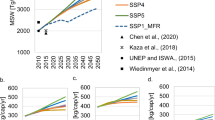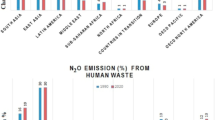Abstract
Landfill disposal of municipal solid waste represents one of the largest anthropogenic global methane emission sources1, and recent policy approaches have targeted significant reductions of these emissions to combat climate change in the US (ref. 2). The efficacy of active gas collection systems in the US was examined by analysing performance data, including fire occurrence, from more than 850 landfills. A generalized linear model showed that the operating status of a landfill—open and actively receiving waste or closed—was the most significant predictor of collection system performance. Gas collection systems at closed landfills were statistically significantly more efficient (p < 0.001) and on average 17 percentage points more efficient than those at open landfills, but open landfills were found to represent 91% of all landfill methane emissions. These results demonstrate the clear need to target open landfills to achieve significant near-term methane emission reductions. This observation is underscored by landfill disposal rates in the US significantly exceeding previously reported national estimates, with this study reporting 262 million tonnes in the year 2012 compared with 122 million tonnes in 2012 as estimated by the US Environmental Protection Agency3.
This is a preview of subscription content, access via your institution
Access options
Subscribe to this journal
Receive 12 print issues and online access
$209.00 per year
only $17.42 per issue
Buy this article
- Purchase on Springer Link
- Instant access to full article PDF
Prices may be subject to local taxes which are calculated during checkout




Similar content being viewed by others
References
IPCC in Climate Change 2013: The Physical Science Basis (eds Stocker, T. F. et al.) (Cambridge Univ. Press, 2013).
Davenport, C. White house unveils plans to cut methane emissions. New York Times (28 March 2014).
Municipal Solid Waste Generation, Recycling, and Disposal in the United States: Facts and Figures 2012 (US EPA, 2014).
Greenhouse Gas Sources and Sinks 1990–2011 (US EPA, 2013).
van Renssen, S. Cleaning up rubbish. Nature Clim. Change 1, 439–440 (2011).
What a Waste: A Global Review of Solid Waste Management (World Bank, 2012).
Proposed Rule—New Source Performance Standards (US EPA, 2014).
Standards of Performance for Municipal Solid Waste Landfills; Proposed Rule 41796-41843 (Federal Register, 2014)
National Fire Incident Reporting System Data: 2004–2010 (US Fire Administration, 2014)
Envirofacts—Greenhouse Gas (US EPA, 2014).
Mandatory Greenhouse Gas Reporting Vol. 40 (Code of Federal Regulations, 2010).
van Haaren, R., Themelis, N. & Goldstein, N. The state of garbage in America. Biocycle 51, 16–23 (2010).
Spokas, K. et al. Methane mass balance at three landfill sites: What is the efficiency of capture by gas collection systems? Waste Manag. 26, 516–525 (2006).
Lohila, A. et al. Micrometeorological measurements of methane and carbon dioxide fluxes at a municipal landfill. Environ. Sci. Technol. 41, 2717–2722 (2007).
Wang, X., Nagpure, A. S., DeCarolis, J. F. & Barlaz, M. A. Characterization of uncertainty in estimation of methane collection from select US landfills. Environ. Sci. Technol. 49, 1545–1551 (2015).
Reinhart, D. R., McCreanor, P. T. & Townsend, T. The bioreactor landfill: Its status and future. Waste Manag. Res. 20, 172–186 (2002).
Wiedinmyer, C., Yokelson, R. J. & Gullett, B. K. Global emissions of trace gases, particulate matter, and hazardous air pollutants from open burning of domestic waste. Environ. Sci. Technol. 48, 9523–9530 (2014).
Powell, J., Jain, P., Kim, H., Townsend, T. & Reinhart, D. Changes in landfill gas quality as a result of controlled air injection. Environ. Sci. Technol. 40, 6 (2006).
Ruokojarvi, P., Ettala, M., Rahkonen, P., Tarhanen, J. & Ruuskanen, J. Polychlorinated Dibenzo-Dioxins and –Furans (PCDDs and PCDFs) in municipal waste landfill fires. Chemosphere 30, 1697–1708 (1995).
El-Fadel, M., Findikakis, A. N. & Leckie, J. O. Environmental impacts of solid waste landfilling. J. Environ. Manag. 50, 1–25 (1997).
Moqbel, S. Y. Characterizing Spontaneous Fires in Landfills PhD thesis, Univ. Central Florida (2009)
Lefebvre, X., Lanini, S. & Houi, D. The role of aerobic activity on refuse temperature rise, I. Landfill experimental study. Waste Manag. Res. 18, 444–452 (2000).
Lanini, S., Houi, D., Aguilar, O. & Lefebvre, X. The role of aerobic activity on refuse temperature rise: II. Experimental and numerical modelling. Waste Manag. Res. 19, 58–69 (2001).
Bridgeton Sanitary Landfill Information (Missouri Department of Natural Resources, 2014); http://www.dnr.mo.gov/bridgeton/index.html
Jambeck, J. R. et al. Plastic waste inputs from land into the ocean. Science 347, 768–771 (2015).
Managing Municipal Waste—A Review of Achievements in 32 European Countries 40 (European Environment Agency, 2013).
Criteria for Municipal Solid Waste Landfills (Code of Federal Regulations, 2012).
Townsend, T. et al. Sustainable Practices for Landfill Design and Operation (Springer, 2015).
Amini, H. R., Reinhart, D. R. & Mackie, K. R. Determination of first-order landfill gas modeling parameters and uncertainties. Waste Manag. 32, 305–316 (2012).
Acknowledgements
This research was financially supported in part by the US EPA’s Office of Research and Development. The manuscript has not been subjected to the Agency’s internal review; therefore, the opinions expressed in this paper are those of the author(s) and do not, necessarily, reflect the official positions and policies of the US EPA. Any mention of products or trade names does not constitute recommendation for use by the US EPA. The data analysis efforts of A. Bigger, M. Falinski, A. Sumner and J. Yap are acknowledged.
Author information
Authors and Affiliations
Contributions
J.T.P. conceived the paper, analysed the data, and wrote the manuscript; T.G.T. and J.B.Z. provided analytical guidance and writing contributions to the manuscript.
Corresponding author
Ethics declarations
Competing interests
The authors declare no competing financial interests.
Supplementary information
Rights and permissions
About this article
Cite this article
Powell, J., Townsend, T. & Zimmerman, J. Estimates of solid waste disposal rates and reduction targets for landfill gas emissions. Nature Clim Change 6, 162–165 (2016). https://doi.org/10.1038/nclimate2804
Received:
Accepted:
Published:
Issue Date:
DOI: https://doi.org/10.1038/nclimate2804
This article is cited by
-
Experimental and analytical study on the potential of reusing waste plastic straps as a replacement for conventional steel stirrups in normal reinforced beams
Innovative Infrastructure Solutions (2024)
-
Energy and materials recovery from post-recycling wastes: WTE
Waste Disposal & Sustainable Energy (2023)
-
Effects of Hydrophobic Biochar-Modified Landfill Soil Cover on Methane Oxidation
Environmental Management (2023)
-
The temporal and spatial characteristics and influencing factors of CO2 emissions from municipal solid waste in China
Environmental Science and Pollution Research (2023)
-
A GIS-based novel approach for suitable sanitary landfill site selection using integrated fuzzy analytic hierarchy process and machine learning algorithms
Environmental Science and Pollution Research (2022)



